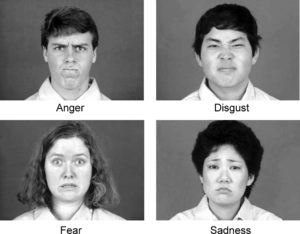 We focus a lot on reading people’s nonverbal behavior, but is there something to be read into about our hair also?
We focus a lot on reading people’s nonverbal behavior, but is there something to be read into about our hair also?
This is precisely what Humintell’s Drs. David Matsumoto and Hyisung Hwang argue in a recent paper. Essentially, while past research has argued that emotional expressions can reveal one’s culture, they argue that differing hairstyles, which are often culturally-linked, confounds these impressions and significantly shape our identifications of other people’s nationalities.
Drs. Matsumoto and Hwang are responding to past research (Marsh et al., 2003) which found a distinctive “accent” between Japanese national and Japanese-American expressions. Essentially, this research asked participants to identify the subject’s nationality (Japanese or American), based on their facial expression. When participants were able to do this, it was attributed to fundamental cultural differences in the form of expression.
However, this may have ignored striking confounders that are not linked just to the facial expression.
For context, when we see a person’s face, we process a host of information, such as their facial structure, expressions, and other artificial features, like piercings, glasses, or hairstyle. Each of these have important impacts on our assessment that are often hard for researchers to untangle.
It was these artificial features which Drs. Matsumoto and Hwang turned to in their study. Because hairstyles often differ between people in different nations, even if they have cultural ties, they developed an experiment to see if this accounted for past findings.
After collecting almost 200 students, they exposed them to a series of images displaying basic emotional expressions on Japanese faces, including the photographs used in the previous study to divide between Japanese nationals and Japanese-Americans. However, half of the photographs were edited to switch hairstyles between the groups, giving Japanese nationals American hairstyles, for instance.
Once the participants were divided between “original” and “switched” groups, participants were shown a series of images and told that some were Japanese nationals and others were Japanese-Americans. Then, upon being shown each image again individually, they were asked to mark the nationality of each.
As hypothesized, hairstyles did impact evaluations for Japanese nationals and reduced the accuracy for Japanese-American neutral expressions. While it is interesting that Japanese-American emotional expressions were not impacted, it is clear that hairstyle plays a significant role.
This necessarily challenges the idea that emotional expressions have a certain “accent” or “cultural dialect.” Instead, many of those differences could be attributed to proclivities to artificial features, like jewelry or hairstyles.
Not only does this demonstrate the importance of universal emotions, as they really are universal, but it also serves as an important lesson for anyone trying to read emotions across cultures. Our brain immediately picks up on these artificial features as it holistically recognizes the face and emotion, so it might take some training to learn to disentangle them!
 It is very easy to fall into the trap of assuming that everyone from a given culture thinks similarly. Psychologists have been doing it for years!
It is very easy to fall into the trap of assuming that everyone from a given culture thinks similarly. Psychologists have been doing it for years! When understanding how other cultures express emotions, it is almost as important to reflect on our own cultural norms as it is to recognize differing ones.
When understanding how other cultures express emotions, it is almost as important to reflect on our own cultural norms as it is to recognize differing ones.